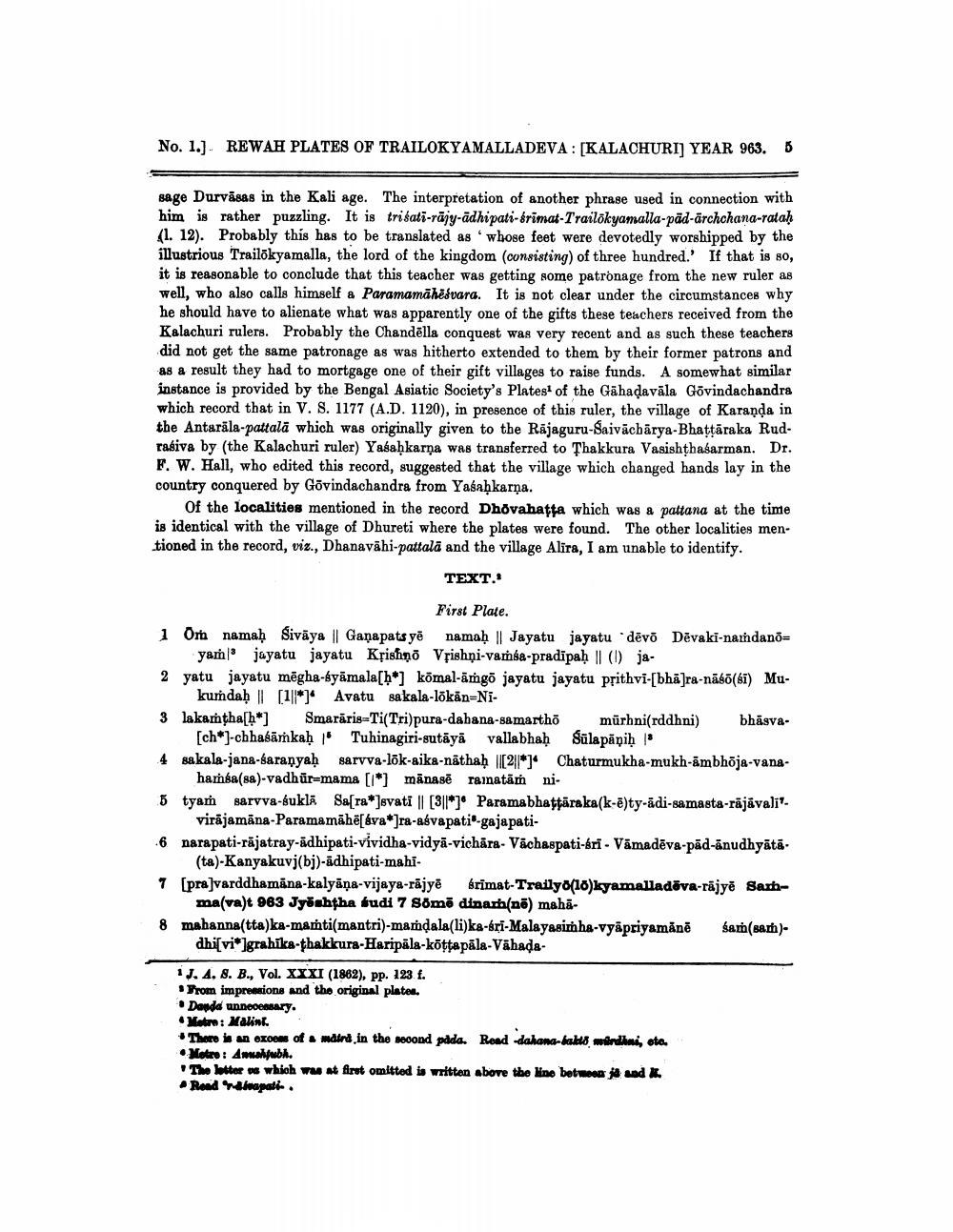________________
No. 1.) REWAH PLATES OF TRAILOKYAMALLADEVA: [KALACHURIJ YEAR 963.0
sage Durvāsas in the Kali age. The interpretation of another phrase used in connection with him is rather puzzling. It is trisati-rājy-adhipati-srimat-Trailökyamalla-päd-archchana-ratah 41. 12). Probably this has to be translated as 'whose feet were devotedly worshipped by the illustrious Trailokyamalla, the lord of the kingdom (consisting) of three hundred.' If that is so, it is reasonable to conclude that this teacher was getting some patronage from the new ruler as well, who also calls himself a Paramamāhësvara. It is not clear under the circumstances why he should have to alienate what was apparently one of the gifts these teachers received from the Kalachuri rulers. Probably the Chandēlla conquest was very recent and as such these teachers did not get the same patronage as was hitherto extended to them by their former patrons and as a result they had to mortgage one of their gift villages to raise funds. A somewhat similar instance is provided by the Bengal Asiatic Society's Platest of the Gāhadavāla Govindachandra which record that in V. S. 1177 (A.D. 1120), in presence of this ruler, the village of Karanda in the Antarala-pattalā which was originally given to the Rajaguru-Saivācbarya-Bhattāraka Rud. rasiva by (the Kalachuri ruler) Yabahkarna was transferred to Thakkura Vasishthabarman. Dr. F. W. Hall, who edited this record, suggested that the village which changed hands lay in the country conquered by Govindachandra from Yasahkarna.
Of the localities mentioned in the record Dhovahatta which was a pattana at the time is identical with the village of Dhureti where the plates were found. The other localities mentioned in the record, viz., Dhanavähi-pattalā and the village Alira, I am unable to identify.
TEXT.
First Plate. 1 Om namah Sivāya || Ganapats yē namaḥ || Jayatu jayatu dēvo Dēvaki-nandano=
yam jayatu jayatu Kpishiņo Vpishội-vamba-pradipaḥ || (1) ja2 yatu jayatu mēgha-byāmala[h*] kõmal-amgo jayatu jayatu prithvi-[bhā]ra-nāso(si) Mu
kumda) || (111*]* Avatu sakala-lõkān=Ni3 lakamtha[h*] Smarāris-Ti( Tri)pura-dabana-samartho mūrhni(rddhni) bhāsva
[ch]-chhaśārkaḥ | Tuhinagiri-sutāyā vallabhaḥ Sulapāṇiḥ | 4 sakala-jana-saranyaḥ sarvva-lõk-aika-nāthaḥ |(211*] Chaturmukha-mukh-ambhõja-vana
hamba(sa)-vadhūr=mama (I*] mānasē rainatam ni5 tyar sarvva-sukla Sa[ra*]svati || [311*7* Paramabhattāraka(k-ē)ty-ādi-samasta-rājávali?
virajamāna-Paramamāhēsáva*]ra-asvapati -gajapati-6 narapati-rājatray-adhipati-vividha-vidyā-vichára- Váchaspati-bri - Vămadēva-pād-anudhyātā.
(ta)-Kanyakuvj(bj)-adhipati-mahi1 (pra)varddhamana-kalyāņa-vijaya-rājyẽ brimat-Traily(10)kyamalladiva-räjyē Samh
ma(va)t 963 Jyoshtha fudi 7 Somā dinam(nő) mahā. 8 mahanna(tta)ka-mamti(mantri)-mamdala(li)ka-sri-Malayasim ha-vyāpriyamānē sam(sam)
dhi[vi]grahīka-thakkura-Haripäla-kottapāla-VähadaiJ. . 8. B., Vol. XXXI (1862), pp. 123 f.
Prom impressions and the original plates. • Dando unnecessary.
Motre: Malink. . There is an oxom of mind in the socond pdda. Read dahan-bakus wordimi, oto. • Metro: Anushubh.
The latter us whioh w at first omitted is written above the Hno between id soda • Rendapati.




